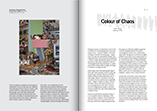
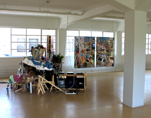

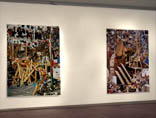
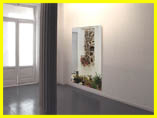
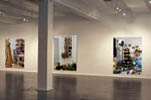
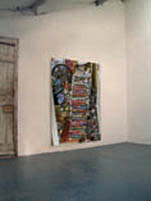
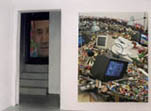
|
|
‘No Pre, No Con’ Galeria Moriarty Madrid 2004
In the work of Paul Eachus we are confronted with a number of immediate questions, or perhaps anomalies, these primarily focus on the status of the object ‘thing’ before us – what kind of thing are we confronted by ? Whilst these large objects are readily identifiable as photographs, large ‘plastic’ surfaces that conform to that ‘lack of regard’ that the photographic surface has for its subject matter there is an uncertainty as to the status of the photograph. For what we perceive is something that falls out of the canons of photographic practice, it fails to locate itself within the familiar tropes of contemporary art photography. It avoids the subtlety of nuanced light effects or the richness of photographic space, it owes more to the arena of catalogue photography – furniture catalogues and mail order books. The light is frontal and clearly studio based, there is a harsh banality to the colour. Similarly what is suggested is that the photograph plays the role of documentation, the recording of an object – a structure or series of structures that exist in another place in the present or the past for which only this inadequate photographic recording exists. This is further emphasised by the cropping process in which, for example, an ongoing event within the built space is severed and partially edited out, we see only a fragment of an event, of which the whole operates outside the frame. So are we looking at a documentation of a physical structure or is what we perceive as a photograph the work itself; this ambiguity seems central to Eachus’s work ?
We are presented, perhaps even propositioned by a series of events, something has taken place, is about to take place or is in the process of taking place. Each event then is in process, not static but in a moment of becoming, it is in this sense transitory; it is unstable. This state of affairs is further complicated by a seeming lack of awareness between events. This space lacks any sense of rational coherence and fails to account for the events going on within its parameters. This is not however a chaotic, out of control situation but one in which the boundaries of things are traversed in order to propose new relationships, relationships formed between unlikely partners. It evokes Deleuze’s notion of ‘delire’, the ‘straight furrows’ fixed by society’s processes of categorisation and the channelling of things into their bracketed places are ruptured and the perverse and the irreconcilable are given the space to form new dialogues.
There is in this ‘space to form new dialogues’ a particular politics at work, in the first instance as a kind of contemporary existentialism, ‘an escaping without leaving’, a resistance to the shackling and controlling power of a capitalist hegemony which in its rhetoric of human freedom becomes increasingly less liberal and egalitarian and more restrictive under the banner of internal security from external aggressors. Interwoven into this situation is the rise of nationalisms and religious fundamentalisms and their attendant moral imperatives. Eachus’s photoworks and displays operate to antagonise and irritate disrupting the smooth flow of things in order to emphasise a notion of becoming, a multi directional immanence that has the potential to ‘burst out’ at any point and at any time. The unlikely partnership between elements of difference provoke the possibility for new formations and debates.
|